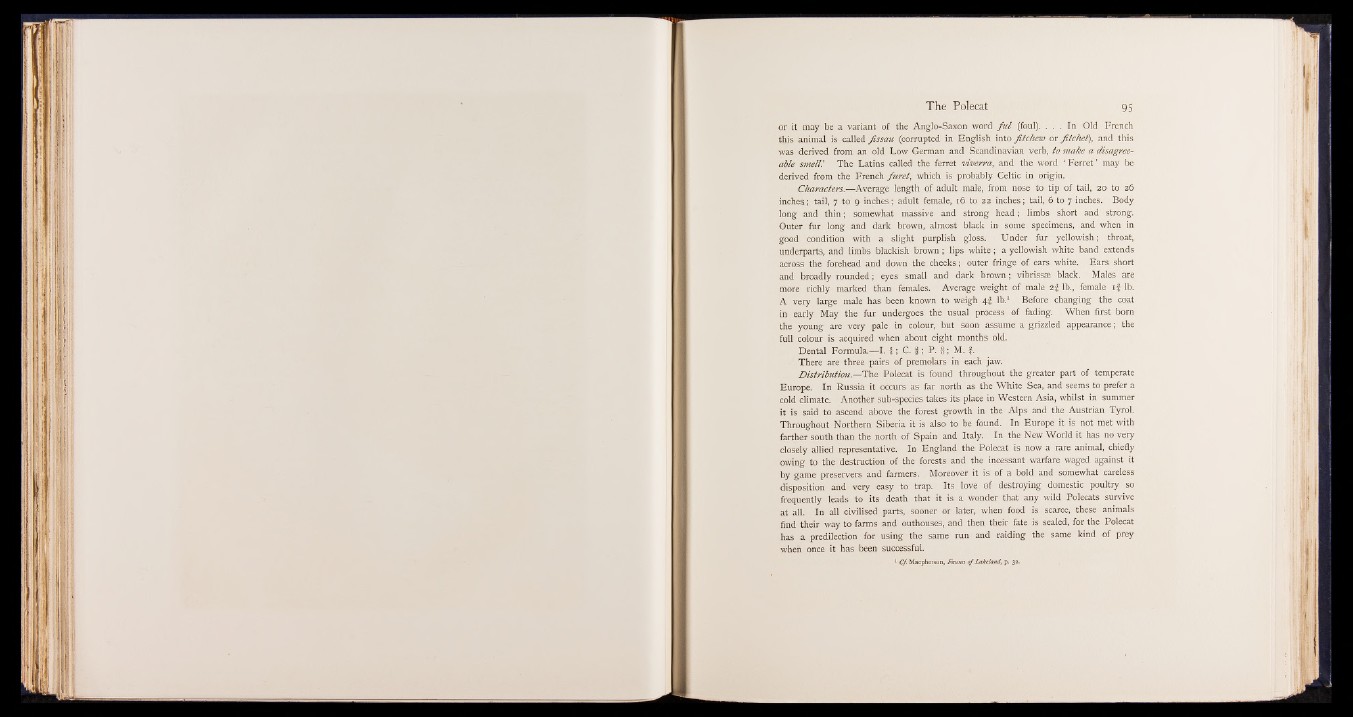
or it may be a variant of the Anglo-Saxon word f u l (foul). . . . In Old French
this animal is- called fissa u (corrupted in English into fitch ew or fitchet), and this
was derived from an old Low German and Scandinavian; verb, to make a disagreeable
sm ell! The Latins called the ferret viverra , and the word ' Ferret ’ may be
derived from the French fiu ret, which is probably Celti& in origin.
Characters.—Average length of adult male, from nose to tip of tail, 20 to 26
in ch e s ta il, 7 to 9 inches; adult female, 16 to 22»ijjthes; tail, 6 to 7 inches.. Body
long and thin; somewhat massive and strong head; limbsbhort and strong.
Outer fur long and dark brown, almost black in some specimens,,- and when in
good condition with a slight, purplish »gloss. WJnder fur yellowish; throat,
underparts, and limbs blackish brown; lips white; a yellowish white band extends
across the forehead and down the cheeks gjputer fringe of ears white, » Ears- short
and broadly rounded; eyes small and dark brown; vibrifsfe» (black. Males are
more richly marked than females. Average weight of male 2 f lb., female i f lb.
A very large male has been known to weigh 4| lb.1 Before changing the coat
in early May the fur undergoes the usual process of fading. When first born
the young are very pale in colour, but soon assume a grizzled appearance; the
full colour is Squired when about eight months old.
Dental Formul||i||i &; C. #; P. f ; M. f.
There are three pairs ew premolars in each jaw.
D istribution. —The Polecat is found throughout the greater part of temperate
Europe. In Russia it occurs as far north as the White Sea, and seems to prefer a
cold climate: Another sub-species takes its place in Western Asia, whilst in summer
it is said to ascend above the forest growth in the Alps and the Austrian Tjrrol.
Throughout Northern »Siberia it i s ’;d |B t o be found. In Europe jtois not met with
farther south than the north of Spain and Italy. In the New World it has no very
closely allied representative. In England the Polecat is now a rare animal, chiefly
owing to the destruction of the forests and the incessant warfare waged against it
by game preservers and farmers. Moreover it is of a bold and somewhat careless
disposition and very easyJfp trap. Its love of destroying. domestiglpoultry so
frequently leads to its death that it is a wonder that any. wild Polecats survive
at all. In all civilised parts, sooner or later, when food is scarce, these animals
find their way to farms and outhouses, and then their fate is sealed, for the Polecat
has a predilection for using the same run and raiding the same kind of prey
when once it has been successful,
1 Cf. Macpherson, Fauna o f Lakeland, p. 32.